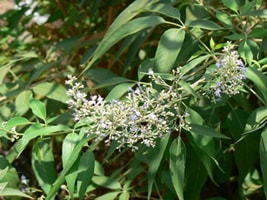
- Latin name – Vitex negundo
- English name – Chaste tree, Five Leafed Chaste Tree, Chasteberry, vitex, Agnus-castus, monk’s pepper, cloister pepper
- Indian name – Nirgundi, Sambhalu
Nirgundi has been used since ancient times as a female remedy and also for pains in Ayurveda and also in Roman medicine. One of its properties was to reduce sexual desire, and it is recorded that Roman wives whose husbands were abroad with the legions spread the aromatic leaves on their couches for this purpose. It became known as the chaste berry tree.
During the Middle Ages, Chaste berry’s supposed effect on sexual desire led to it becoming a food spice at monasteries, where it was called "Monk’s pepper" or "Cloister pepper."
In tradition, it was also known as an important European remedy for controlling and regulating the female reproductive system. Long used to regularize monthly periods and treat amenorrhoea and Dysmenorrhea, it also helped ease menopausal problems and aided the birth process.
Hippocrates, Dioscorides, and Theophrastus mention the use of Vitex for a wide variety of conditions, including hemorrhage following childbirth, and also to assist with the “passing of afterbirth.” Decoctions of the fruit and plant were also used in sitz baths for diseases of the uterus.
Plant Description
Vitex negundo is from Verbenaceae family and is a well-known aromatic shrub to small tree growing in the Mediterranean area to western Asia and India. The plant has long spires of pale lilac or rose-colored flowers and small gray-brown, hard fruits, which is the part used medicinally. It is often found growing next to streams, and it loves water, but this author has seen it growing in very dry, rocky spots on the Greek islands.
Vitex usually grows from three to nine feet tall, but under cultivation can develop to 20 feet tall. The bark is white-felted; the opposite leaves are palmately compound with 5-7 leaflets. The flowers are in interrupted spikes and the corolla is two-lipped from 6-9 mm long. The fruit is a small hard reddish-black drupe with a persistent calyx.
Chemical Constituents
The chemical constituents are the monoterpenes agnuside, eurostoside, and aucubin. Vitex negundo also contains the flavonoids casticin, chryso-splenol and vitexin. Vitex contains Chrysoplenol D. which is a substance with anti-histamine properties and muscle relaxant.
Parts Used
Leaves Powder.
Benefits of Nirgundi
- Amenorrhea
- Menopause
- Menorrhagia (Heavy Menstruation)
- Menstrual Difficulties (Secondary Amenorrhea)
- Premenstrual Syndrome
- Rheumatism
- Skin diseases
- Arthritis and pains
- Ulcers
Classical Reference
Dosage
- Nirgundi Juice – 20 to 30 ml p er day,
- Nirgundi leaf Powder – 3-6 grams per day.
To buy Nirgundi Powder, please visit store.planetayurveda.com/products/nirgundi-powder

